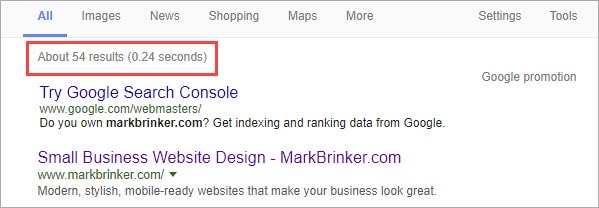
First, the bad news.
It’s impossible to give you an exact timeframe for how long it takes a new website to appear on Google.
Your site could get indexed by Google within a matter … weeks … or longer.
That’s because you and I don’t control Google. Their algorithm indexes your site when it decides to index your site. I wish there was a more definitive answer, but that’s the reality of the situation.
Anybody claiming otherwise isn’t being truthful.
Now for the good news.
Even though you can’t force Google to rank your new site immediately, there are definitely things you can (and should) do to keep your wait time to a minimum. Here they are …
The Google Visibility Checklist For New Websites
- Robots.txt. Make sure your robots.txt file is not inadvertently blocking search engine crawlers and bots from the content you want Google to index. If you’re not familiar with the robots.txt file, you can learn about it here. The person or company that built your website should know how to check your robots.txt file to make sure it’s set up correctly.
- WordPress Dashboard. If your website is built on the the WordPress platform, there is a setting in your WordPress dashboard saying “discourage search engines from indexing this site”. It is common to have this setting turned on when a new site is under construction and you don’t want search engine crawlers trying to index your site. But after launching your site, you must remember to turning this setting *off*.
- Google Search Console. Connect your site with Google Search Console (formerly Google Webmaster Tools). This is a free service offered by Google that analyzes your site and notifies you of any errors. Google Search Console allows you to submit your sitemap and/or individual page URLs directly to Google for consideration for indexing in their database.
- Google Analytics. Make sure to integrate Google Analytics with your site. Like Google Search Console, this is a free service but it focuses more on logging and analyzing the traffic to your site. Connecting your site to Google Analytics is another way to “ping” the Google ecosystem to let them know you exist.
- On-Page SEO. To show up on Google, your pages must be formatted correctly so they’re search-engine friendly. It’s beyond the scope of this article to tell you everything you need to know about On-Page SEO, but here’s a good On-Page SEO checklist to get you started. Perhaps the most important part of On-Page SEO are the meta tags — specifically the title tag and description tag. Although there are no guarantees, if you configure your meta tags correctly Google will often use your meta tag info word-for-word, which means you’ll be able to sculpt how your search listings appear in Google.
- Local SEO. Remember to set up your free Google My Business listing. If you need help with this, here’s a great resource. Google My Business is one of the quickest and easiest ways to get visibility in your local market. Even if it takes a few weeks for your site to show up in Google’s organic SERPs (Search Engine Results Pages), at least you can occupy some first page real estate on Google with your Google My Business listing.
- Backlinks. Another way to get Google’s attention is to have as many other websites as possible linking back to your site. The more, the merrier. You don’t need to resort to any spammy, blackhat SEO tactics to get backlinks. All you need is a little time and elbow grease. Start with the obvious. Go to all your social media properties like Facebook, LinkedIn and Twitter and make sure they all link back to your website. Then start updating your profiles on places like the online Yellow Pages, Manta, Yelp or your local Chamber of Commerce. There are tons of opportunities for easy backlinks if you just roll up your sleeves and dig a little bit.
- Content. Publishing high-quality, useful content on your website helps your search engine visibility in two ways. First, it gives Google’s search engine crawlers raw data to consume and index in their database. One well-written piece of content could result in page 1 listings on Google for many search terms. Second, a high-quality piece of content can result in backlinks to your site from other website owners or bloggers. Remember, backlinks are one of the main ways Google keeps score to determine if website content is valuable and deserving of a page 1 listing.
If you implement this checklist, the likelihood of showing up on Google sooner rather than later increase tremendously versus just sitting there doing nothing.
Getting Indexed vs. Appearing In The Search Results
Although they sound the same, getting your site indexed by Google and showing up in their search listings are actually two different things.
Getting indexed just means that a page on your website made it into Google’s database, which is a good first step. You can check which pages of your site are indexed by doing a Google search for site:yourdomain.com.
For example, if I wanted to check how many pages of my site are currently indexed by Google, it would look like this:

It would then return this result, which tells me I currently have 54 pages indexed by Google:

However, just because Google has indexed your website, that doesn’t mean you’ll show up in their page 1 search listings for your desired term. Being listed on page 1 of Google for a specific search term is what everyone wants, but not everyone gets. There are many factors that determine what Google displays on page 1, not to mention there are limited spots available on page 1.
For example, if you do a Google search for “small business website cost”, you’ll find me on page 1. If you Google “small business website design”, I’m not on page 1 — even though my site is fully indexed by Google. Sometimes Google puts you on page 1 for a particular search term, sometimes they don’t.
A Little-Known Tactic For Instant First Page Visibility On Google
When someone Google’s your name or the name of your business, wouldn’t it be nice if you were always the first thing they saw?
Even though you can’t control if or when you’ll appear in the top spot in Google’s organic search results, there is a clever little tactic that will always get you to the top of the page when someone Googles your name. It’s ridiculously easy to do, and I’m kind of surprised more people don’t do this.
The secret is to run a “brand campaign” with Google Adwords. Let me show you how this works. I’ll use me as an example.
Let’s say you wanted to redesign your website and a friend of yours says, “Hey, Mark Brinker redesigned our site and it came out great. You should give him a call.” So you do a Google search for “Mark Brinker” and here’s what you find:

Position # 1 right at the top of the page. No need to hunt, peck or scroll.
Big deal, so what?
Well, if I don’t run this simple ad when someone Googles my name, I’m pretty much invisible because there a prominent orthopedic surgeon (more famous than me) also named Mark Brinker that dominates the first page of Google for the search term “Mark Brinker”.
So if I want to cut to the front of the line, all I have to do is give Google a few bucks and — boom — I’m in the top spot. It’s that easy.
The reason why it’s important to be near the top of the page on Google is because it’s well-documented that the higher up you are on the page, the more clicks you’ll get.
Even more important, when someone does a Google search for my name, it often means they’ve been referred to me, which means they’re probably very interested in talking with me. So I want to make it as easy as possible for them to get to my website.
Brand campaigns are very simple and inexpensive to run. What’s great about Adwords is that you only pay if someone clicks on your ad. And right now, my brand campaign costs me a whopping 96 cents per click. That’s peanuts for premium name visibility on Google.
Here’s The Recap For Getting Your New Site To Appear On Google
- Action is required. Simply launching your new website is not enough. As outlined above, your site must be configured correctly and Google must be able to access it. In addition, I’ve also explained proactive steps you can take to increase the likelihood of getting listed in the Google search results in the shortest time possible.
- Be patient. This isn’t an overnight process and you can’t force Google to speed things up. Be wary of “experts” that charge a fortune for “insider secrets” for getting listed on Google. If you methodically execute tried and true best practices, you’ll eventually show up on Google.
- Create a brand campaign. While you’re waiting for your site to be discovered by Google and bubble up to the top of their search results, consider running a brand campaign so you’ll be at the top of the page when someone Google’s your name or the name of your business. It’s inexpensive, fairly simple to set up and it gives you instant visibility on Google.
Hopefully this demystifies things a bit when it comes to getting your new site to show up on Google.

This website is unbelievable. Information provided here is very helpful.
Thank you
Great post! Love the content. It may take awhile for anyone to show up in Google, but eventually you will get indexed and with the correct amount of SEO you'll be on your way.
Yes, the Google search console can give you an ahead for indexing your site in Google. I have seen many people doing this as it is like registering your new place to Google, and Google can easily pick up your site to index.
This was truly the clearest and most helpful thing I've read about this topic, Thank you!
Thank you for the article. We was unsure how long it took for Google to crawl our blog posts.